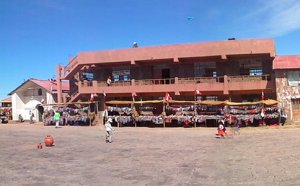
What does Peru imports?
Peru's exports and imports have been therefore volatile, owing both to additional changes also to inner problems, that it is difficult to determine exactly what might be considered typical structures of trade. Measured with regards to bucks, exports rose considerably from 1970 to 1980, from US$1.0 billion to US$3.9 billion, nonetheless they then fell returning to US$2.5 billion by 1986. Imports were under exports in 1970, at US$700 million, but tripled in the next 5 years as a result of the hefty investing of the military government because period. Imports were drawn to US$1.7 billion by 1978, then hopped to US$3.8 billion in 1981 given that Belande government both liberalized imports and increased its very own spending. At the end of the ten years, in 1989, the failure of domestic economic task pulled imports back off to US$2.0 billion, exactly where they'd already been 10 years earlier. Considering that the exact same collapse of domestic product sales encouraged increased attempts to export, Peru completed the decade with a record trade excess of US$1.6 billion. The surplus wasn't much an achievement since it was caused by failure to maintain financial growth (see table 15, Appendix).
In an assessment of exports of products and solutions to GDP, the country's export ratio was 16 % in 1965 but dropped to 10 % by 1988. Imports of goods and services had been 19 % of GDP in 1965 and 14 percent in 1988, giving the united states a net resource inflow equal to 3 % of GDP in the last 12 months and 4 percent in 1988.
Using 1988 as something close to a representative 12 months (in order to avoid the particularly strained conditions of 1989 and 1990), exports of products included US$1.4 billion well worth of conventional items and US$0.8 billion of more diversified nontraditional items. Both of these values had been, unhappily, below their particular levels by 1980 (see table 16, Appendix). Metals and petroleum had been the most important items. The key steel items taken into account 50.6 percent of total commodity export earnings, with petroleum and its particular derivatives adding 8 %. Copper stood out, because has for several years, accounting for 22.3 per cent of earnings in 1990, down slightly from above 24 percent in 1970. Zinc exports climbed rapidly between these 20 years, achieving 12.6 % associated with the total in 1990. An assessment of 1970 and 1990 somewhat misleadingly recommends strong growth for petroleum exports, from a negligible level in 1970 to 8 % of total exports in 1990. This suggestion is misleading because oil exports in fact achieved their particular peak in 1980, at US$792 million and 20 per cent of total exports. By 1990 their value had fallen, at reduced costs, to US$263 million.
Agricultural exports were reduced than those from the mining industry, however the four major products-coffee, cotton fiber, seafood dinner, and sugar-added up to 19 % of complete exports in 1988. They didn't show much development between 1970 and 1988, rising just from US$462 to US$523 million over this eighteen-year period.
Peru's future development prospects rely crucially regarding ability to develop brand-new exports, preferably manufacturing exports and much more diversified, higher-value, major items to supplement the original products. Manufacturing exports are free from the built-in restrictions of production enforced by dependence on exhaustible all-natural resources, and their particular areas usually are much more steady compared to those for main items. For Peruvian industrialists who've restricted their particular focus mainly to protected domestic areas, produced goods provide both a competitive stimulation and essential learning opportunities. If more Peruvian producers enter export markets effectively, the customers for development of output as well as entrepreneurial ability could considerably enhance.
Peruvian industrial businesses appeared to be beginning this crucial transition within the 1960-80 duration, however the brand new trend went into reverse. Exports of manufactured goods had been US$743 million in 1980, but by 1987 that they had fallen to US$540 million. In 1987 the production industry's imports of inputs for manufacturing as well as money equipment had been almost triple its exports.
The production industry's failure up to now to increase exports even near to the degree of its very own imports is an important problem for Peru. The difficulty could in theory be solved by altering two areas of national financial policy having worked powerfully to attend manufacturing exports. Among the two crucial obstacles has been the higher rate of efficient protection for industrial services and products. High defense boosts the profitability of offering toward real estate market versus exporting and in addition causes it to be difficult to participate overseas as it raises the values of inputs for Peruvian organizations above the intercontinental prices available to rivals in other countries. Peruvian security ended up being considerably raised when you look at the 1960s then once again, after short-term reductions, in second half of 1980s. As talked about the following, the Fujimori government went back others means: it simplified the tariff structure and made significant reductions when it comes to products with the highest rates of defense. These modifications should make it possible to launch constraints on manufacturing exports, although most likely results rely on the other crucial plan variable concerned, the exchange rate.
RELATED VIDEO



Share this Post
Related posts
All Inclusive Resorts in Central America
Discover the normal splendour and dazzling surroundings of Central The united states with Signature holidays . Connecting…
Read MorePeru Adventure Tours
One of our most popular destinations in South America, our Peru adventure trips provide an extraordinary selection of experiences…
Read More

